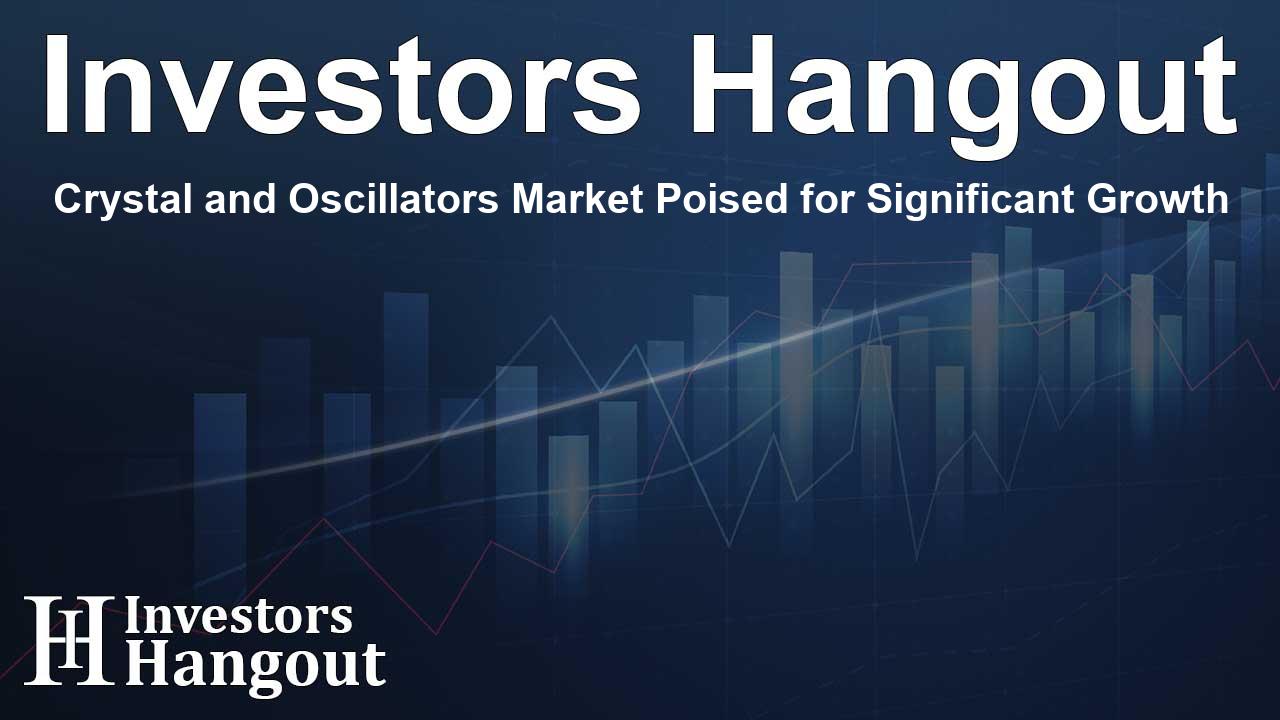Crystal and Oscillators Market Poised for Significant Growth

The Future of the Crystal and Oscillators Market
The crystal and oscillators market is currently in a phase of promising expansion, with estimations indicating it will grow from approximately $7.5 billion in 2024 to a projected $11.2 billion by 2034. This anticipated growth translates to a compound annual growth rate (CAGR) of about 4.2% over the next decade, driven primarily by advancements in wireless communication technologies and the proliferation of Internet of Things (IoT) devices.
Key Drivers Fueling Market Growth
A critical factor contributing to this market progression is the increasing demand for precise frequency control across various industries such as telecommunications, automotive, and consumer electronics. The global shift toward 5G networks plays a significant role in this paradigm shift, with next-generation networks requiring superior oscillator technology for optimal performance.
The integration of advanced materials is another notable trend, enhancing the miniaturization and effectiveness of oscillators, notably for applications in ultra-reliable environments like aerospace and defense, as well as in consumer electronic devices.
Market Dynamics and Trends
Technological innovations have been pivotal in shaping the future of the crystal and oscillators market. With industries undergoing digital transformation, oscillators have emerged as essential components that ensure accurate timing and frequency references for electronic devices. This is particularly vital as the infrastructure for 5G expands and IoT systems become increasingly intricate.
The energy-efficient nature of modern oscillator solutions is also a determining factor, especially in sectors like healthcare and automation, where reliability and precision are crucial. Despite these opportunities, the industry faces several challenges, including potential supply chain disruptions and fluctuations in raw material prices, alongside rigorous regulatory conditions that could impede growth.
Segmentation Analysis
When viewed through the lens of product offerings, quartz crystals currently dominate the market landscape, representing a substantial 35% of overall market share. These crystals are widely recognized for their reliability and affordability, particularly in consumer electronics and telecommunications. Furthermore, MEMS oscillators are on the rise, holding a 20% market share due to their compact design and reduced power requirements, making them advantageous for automotive applications and portable electronics.
SAW oscillators comprise 15% of the market, frequently utilized in RF and wireless applications. Moreover, temperature-controlled oscillators such as TCXO, VCXO, and OCXO contribute to about 30% of total market share due to their application in sectors demanding high precision and accuracy, especially within aerospace and military sectors.
Application Insights
The telecommunications sector remains the largest single application market for oscillators, accounting for approximately 40% of overall demand, driven by robust investments in 5G and broadband infrastructure development. Following closely is the consumer electronics sector, contributing around 30% to the market, buoyed by the rapid growth of smart devices. Additionally, the automotive sector’s share is close to 15%, with augmented demand linked to electric vehicle advancements and enhanced driver-assistance technologies.
On the end-user front, original equipment manufacturers (OEMs) constitute a dominant 70%, underscoring the reliance on high-quality oscillators due to their integration into high-performance products. The aftermarket segment, representing 30% of the market, continues to gain traction, emphasizing the importance of support and replacement services.
Regional Markets and Distribution Channels
Geographically, the Asia-Pacific region leads the market, generating approximately 45% of global revenue. As technology adoption accelerates, North America is emerging as a rapid growth region, projecting a CAGR of around 5% through 2034, primarily due to its strong technology sector and willingness to invest in R&D.
Europe, Latin America, and the Middle East collectively represent significant portions of the market, pushed forward by industrial advancements and the demand for advanced communication systems.
Distribution-wise, direct sales channels dominate with a 50% share of market transactions, a reflection of strong partnerships with OEMs. Distributors actions follow closely at roughly 30%, offering logistical benefits, while online sales channels are expanding swiftly, claiming about 20% of the total volume.
Emerging Opportunities
The future outlook for the crystal and oscillators market is intrinsically linked to technological developments in AI, autonomous vehicles, and e-health systems, each requiring high levels of accuracy and timing reliability. The rise in eco-friendly manufacturing practices presents additional avenues for growth, particularly in developing oscillators that support cutting-edge applications.
In summary, the crystal and oscillators market is on a prosperous incline, driven by transformative digital innovations and evolving consumer demands. As the sector navigates challenges associated with supply chains and regulatory pressures, the long-term perspective remains favorable, leading to many new opportunities for innovation and market growth.
Frequently Asked Questions
1. What is the projected market value of crystal oscillators by 2034?
The crystal oscillators market is expected to reach approximately $11.2 billion by 2034.
2. What are the key factors driving market growth?
Technological innovation, increased IoT device adoption, and the transition to 5G networks are the main factors driving market growth.
3. Which sector is the largest market for crystal oscillators?
Telecommunications remains the largest application segment, accounting for about 40% of the total demand.
4. What challenges does the market face?
Challenges include supply chain disruptions, raw material price fluctuations, and strict regulatory requirements.
5. Which region leads the crystal oscillators market?
The Asia-Pacific region leads the market, contributing around 45% of global revenue.
About The Author
Contact Thomas Cooper privately here. Or send an email with ATTN: Thomas Cooper as the subject to contact@investorshangout.com.
About Investors Hangout
Investors Hangout is a leading online stock forum for financial discussion and learning, offering a wide range of free tools and resources. It draws in traders of all levels, who exchange market knowledge, investigate trading tactics, and keep an eye on industry developments in real time. Featuring financial articles, stock message boards, quotes, charts, company profiles, and live news updates. Through cooperative learning and a wealth of informational resources, it helps users from novices creating their first portfolios to experts honing their techniques. Join Investors Hangout today: https://investorshangout.com/
The content of this article is based on factual, publicly available information and does not represent legal, financial, or investment advice. Investors Hangout does not offer financial advice, and the author is not a licensed financial advisor. Consult a qualified advisor before making any financial or investment decisions based on this article. This article should not be considered advice to purchase, sell, or hold any securities or other investments. If any of the material provided here is inaccurate, please contact us for corrections.
